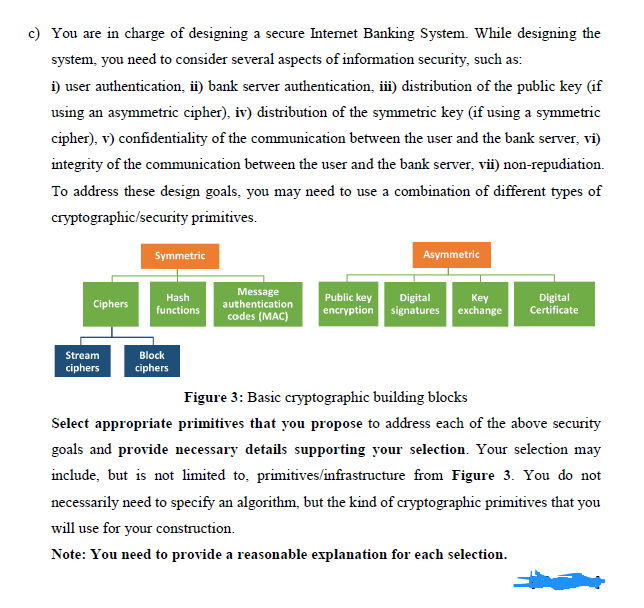c) You are in charge of designing a secure Internet Banking System. While designing the system, you need to consider several aspects of information security, such as: i) user authentication, ii) bank server authentication, iii) distribution of the public key (if using an asymmetric cipher), iv) distribution of the symmetric key (if using a symmetric cipher), v) confidentiality of the communication between the user and the bank server, vi) integrity of the communication between the user and the bank server, vii) non-repudiation. To address these design goals, you may need to use a combination of different types of cryptographic/security primitives.
c) You are in charge of designing a secure Internet Banking System. While designing the system, you need to consider several aspects of information security, such as: i) user authentication, ii) bank server authentication, iii) distribution of the public key (if using an asymmetric cipher), iv) distribution of the symmetric key (if using a symmetric cipher), v) confidentiality of the communication between the user and the bank server, vi) integrity of the communication between the user and the bank server, vii) non-repudiation. To address these design goals, you may need to use a combination of different types of cryptographic/security primitives.
Computer Networking: A Top-Down Approach (7th Edition)
7th Edition
ISBN:9780133594140
Author:James Kurose, Keith Ross
Publisher:James Kurose, Keith Ross
Chapter1: Computer Networks And The Internet
Section: Chapter Questions
Problem R1RQ: What is the difference between a host and an end system? List several different types of end...
Related questions
Question

Transcribed Image Text:c) You are in charge of designing a secure Internet Banking System. While designing the
system, you need to consider several aspects of information security, such as:
i) user authentication, ii) bank server authentication, iii) distribution of the public key (if
using an asymmetric cipher), iv) distribution of the symmetric key (if using a symmetric
cipher), v) confidentiality of the communication between the user and the bank server, vi)
integrity of the communication between the user and the bank server, vii) non-repudiation.
To address these design goals, you may need to use a combination of different types of
cryptographic/security primitives.
Symmetric
Asymmetric
Message
authentication
Digital
encryption signatures exchange
Hash
Public key
Key
Digital
Certificate
Ciphers
functions
cades (MAC)
Stream
Block
ciphers
ciphers
Figure 3: Basic cryptographic building blocks
Select appropriate primitives that you propose to address each of the above security
goals and provide necessary details supporting your selection. Your selection may
include, but is not limited to, primitives/infrastructure from Figure 3. You do not
necessarily need to specify an algorithm, but the kind of cryptographic primitives that you
will use for your construction.
Note: You need to provide a reasonable explanation for each selection.
Expert Solution
This question has been solved!
Explore an expertly crafted, step-by-step solution for a thorough understanding of key concepts.
Step by step
Solved in 2 steps

Recommended textbooks for you

Computer Networking: A Top-Down Approach (7th Edi…
Computer Engineering
ISBN:
9780133594140
Author:
James Kurose, Keith Ross
Publisher:
PEARSON

Computer Organization and Design MIPS Edition, Fi…
Computer Engineering
ISBN:
9780124077263
Author:
David A. Patterson, John L. Hennessy
Publisher:
Elsevier Science

Network+ Guide to Networks (MindTap Course List)
Computer Engineering
ISBN:
9781337569330
Author:
Jill West, Tamara Dean, Jean Andrews
Publisher:
Cengage Learning

Computer Networking: A Top-Down Approach (7th Edi…
Computer Engineering
ISBN:
9780133594140
Author:
James Kurose, Keith Ross
Publisher:
PEARSON

Computer Organization and Design MIPS Edition, Fi…
Computer Engineering
ISBN:
9780124077263
Author:
David A. Patterson, John L. Hennessy
Publisher:
Elsevier Science

Network+ Guide to Networks (MindTap Course List)
Computer Engineering
ISBN:
9781337569330
Author:
Jill West, Tamara Dean, Jean Andrews
Publisher:
Cengage Learning

Concepts of Database Management
Computer Engineering
ISBN:
9781337093422
Author:
Joy L. Starks, Philip J. Pratt, Mary Z. Last
Publisher:
Cengage Learning

Prelude to Programming
Computer Engineering
ISBN:
9780133750423
Author:
VENIT, Stewart
Publisher:
Pearson Education

Sc Business Data Communications and Networking, T…
Computer Engineering
ISBN:
9781119368830
Author:
FITZGERALD
Publisher:
WILEY